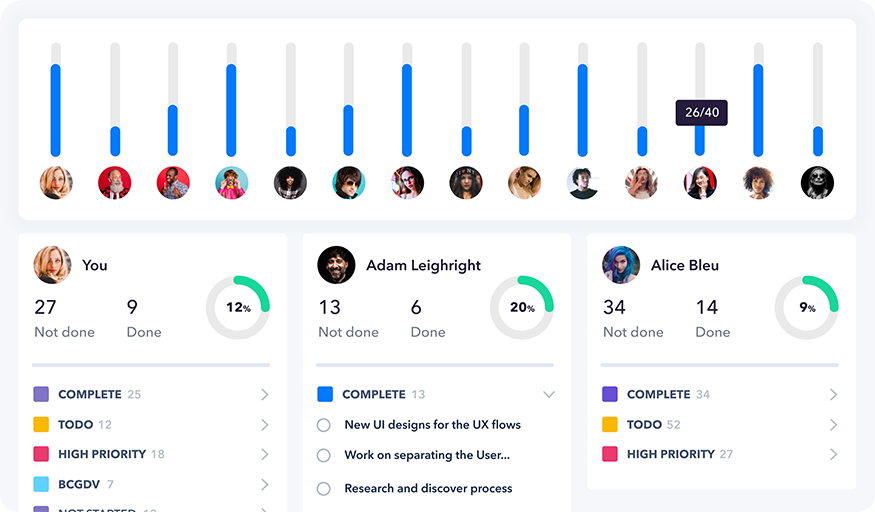The United States has more than 1.5 million nonprofit organizations generating 10 percent of all national employment. These nonprofits are continuously holding events, executing campaigns, rolling out initiatives, and building relationships with donors. To ensure the success of project and event management for nonprofits, it’s important for nonprofits to use the right project management tools.
In this article, we define project management, explain its importance for nonprofits, and share steps to successfully hold projects and events.
 What is project and event management for nonprofit?
What is project and event management for nonprofit?
Project management ensures that a project is successfully completed and that it meets its objectives. In the case of a nonprofit, the project can be an event, a fundraising campaign, a volunteer drive, or a new program.
Each project would have a dedicated project manager and a documented process that uses appropriate skills and tools to ensure the seamless functioning of the project or event. With project management, projects are not just executed on time but also effectively using necessary resources and within budget.
Why project and event management for nonprofits is needed
Let’s look at the statistics first. The Project Management Institute reports that only about 16 percent of nonprofit projects are executed on time. Around 53 percent of projects exceed their budget and 31 percent of all projects get canceled.
It’s obvious that there is considerable wastage of resources. Project management can help solve the problem. With a documented project management process, your nonprofit can:
- Decide on all your tasks at once and easily
- Get an overview of all finished and upcoming projects
- Optimize your work and focus on important tasks
- Centralize information and give access to everyone
- Manage a calendar of the timeframe of all projects
- Monitor the status of your projects
- Link connected tasks to save time and energy
- Easily communicate and exchange documents with others
- Manage team members’ responsibilities
- Easily execute routine tasks including newsletters and annual reports
A credible project management tool like Heycollab gives you a team dashboard that shows a holistic view of your team and a range of tasks, timelines, and deadlines for your entire nonprofit.

Manage your team in Heycollab
5 steps for successful project and event management for nonprofits
Success is rarely the result of haphazard tactics. It needs a structured plan with a repeatable framework. These five steps will help you achieve that and ensure that your nonprofit project or event is successful.
1. Set your objectives
Begin by defining the goals of your project. Whether it’s a fundraiser or a campaign to raise awareness, you should know what you expect from the project. The mission will help define the various tasks and tell you who should be leading it and who should be involved.
Importantly, it will provide yardsticks for measuring your nonprofit’s performance at the end of the project.
2. Create a budget
Although it might evolve as you add or remove functions or resources, it’s important to start with a budget. Look at your past events or those of others and you’ll have a better idea of how much it would cost.
Your budget could include venue costs, rental expenses, catering costs, stage decoration expenses, and entertainment costs. All these should be tracked in a document by the project manager. You can use Heycollab’s video calling to hold impromptu meetings to seek clarifications on budgets or schedule regular meetings for your team from within the app.
3. Raise funds or get sponsors
Once you have calculated your budget, it’s time to arrange funds for the event. You could look at past sponsors, whether it’s institutions or individuals. You can also opt for crowdfunding or sell tickets for the event.
While approaching sponsors, share a persuasive document that lays out your objectives, track record, event details, media stories about your nonprofit, and any recognition you might have won. All these increase your credibility and make it easy to raise funds.
4. Design the event
Once you’ve lined up sponsors, it’s time to design all the aspects of the event. These include the venue, date and time, theme of the event, decor (whether it would have marketing assets of your sponsors), guests, speakers, food and drinks, number of volunteers, registration method, transportation, parking, etc.
Think of it as a checklist that, once developed, can be used for all future events. Heycollab’s My Work allows you to see and understand your work and your contribution to the nonprofit. This will immensely help you manage your workload and be more productive.
 5. Market the event
5. Market the event
Marketing is a crucial factor in the success of any event. An individual with relevant experience should be put in charge of marketing. You can look at your previous events or those run by others to figure out the marketing channels you would have to use.
Design your promotional materials and deploy them through cost-effective digital media tactics, radio ads, or flyers. With Heycollab’s screen sharing, team members can share their designs and tasks with others to get feedback in real time.
In short
Through such a structured project management process, project and event management in nonprofits can become more effective and successful.
————-
Heycollab is a project management tool built for teams like yours. With a free 14-day trial you can try out all the cool features. To get started visit https://heycollab.com/

